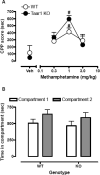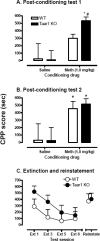Augmentation of methamphetamine-induced behaviors in transgenic mice lacking the trace amine-associated receptor 1
- PMID: 22079347
- PMCID: PMC3288391
- DOI: 10.1016/j.pbb.2011.10.025
Augmentation of methamphetamine-induced behaviors in transgenic mice lacking the trace amine-associated receptor 1
Abstract
The trace amine-associated receptor 1 (TAAR1) is a G protein-coupled receptor that is functionally activated by amphetamine-based psychostimulants, including amphetamine, methamphetamine and MDMA. Previous studies have shown that in transgenic mice lacking the TAAR1 gene (TAAR1 knockout; KO) a single injection of amphetamine can produce enhanced behavioral responses compared to responses evoked in wild-type (WT) mice. Further, the psychostimulant effects of cocaine can be diminished by selective activation of TAAR1. These findings suggest that TAAR1 might be implicated in the rewarding properties of psychostimulants. To investigate the role of TAAR1 in the rewarding effects of drugs of abuse, the psychomotor stimulating effects of amphetamine and methamphetamine and the conditioned rewarding effects of methamphetamine and morphine were compared between WT and TAAR1 KO mice. In locomotor activity studies, both single and repeated exposure to d-amphetamine or methamphetamine generated significantly higher levels of total distance traveled in TAAR1 KO mice compared to WT mice. In conditioned place preference (CPP) studies, TAAR1 KO mice acquired methamphetamine-induced CPP earlier than WT mice and retained CPP longer during extinction training. In morphine-induced CPP, both WT and KO genotypes displayed similar levels of CPP. Results from locomotor activity studies suggest that TAAR1 may have a modulatory role in the behavioral sensitization to amphetamine-based psychostimulants. That methamphetamine-but not morphine-induced CPP was augmented in TAAR1 KO mice suggests a selective role of TAAR1 in the conditioned reinforcing effects of methamphetamine. Collectively, these findings provide support for a regulatory role of TAAR1 in methamphetamine signaling.
Copyright © 2011 Elsevier Inc. All rights reserved.
Figures





References
-
- Achat-Mendes C, Ali SF, Itzhak Y. Differential effects of amphetamines-induced neurotoxicity on appetitive and aversive Pavlovian conditioning in mice. Neuropsychopharmacology. 2005;30:1128–1137. - PubMed
-
- Bardo MT, Bevins RA. Conditioned place preference: what does it add to our preclinical understanding of drug reward? Psychopharmacology (Berl) 2000;153:31–43. - PubMed
-
- Berry MD. The potential of trace amines and their receptors for treating neurological and psychiatric diseases. Rev Recent Clin Trials. 2007;2:3–19. - PubMed
-
- Borowsky B, Adham N, Jones KA, Raddatz R, Artymyshyn R, Ogozalek KL, Durkin MM, Lakhlani PP, Bonini JA, Pathirana S, Boyle N, Pu X, Kouranova E, Lichtblau H, Ochoa FY, Branchek TA, Gerald C. Trace amines: identification of a family of mammalian G protein-coupled receptors. Proc Natl Acad Sci U S A. 2001;98:8966–8971. - PMC - PubMed
-
- Bradaia A, Trube G, Stalder H, Norcross RD, Ozmen L, Wettstein JG, Pinard A, Buchy D, Gassmann M, Hoener MC, Bettler B. The selective antagonist EPPTB reveals TAAR1-mediated regulatory mechanisms in dopaminergic neurons of the mesolimbic system. Proc. Natl. Acad. Sci. U S A. 2009;106:20081–20086. - PMC - PubMed
Publication types
MeSH terms
Substances
Grants and funding
LinkOut - more resources
Full Text Sources
Medical
Molecular Biology Databases
Research Materials

